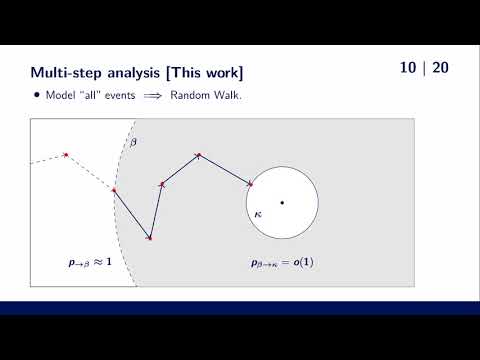CryptoDB
The Randomized Slicer for CVPP: Sharper, Faster, Smaller, Batchier
| Authors: | |
|---|---|
| Download: | |
| Presentation: | Slides |
| Abstract: | Following the recent line of work on solving the closest vector problem with preprocessing (CVPP) using approximate Voronoi cells, we improve upon previous results in the following ways: We derive sharp asymptotic bounds on the success probability of the randomized slicer, by modelling the behaviour of the algorithm as a random walk on the coset of the lattice of the target vector. We thereby solve the open question left by Doulgerakis–Laarhoven–De Weger [PQCrypto 2019] and Laarhoven [MathCrypt 2019]. We obtain better trade-offs for CVPP and its generalisations (strictly, in certain regimes), both with and without nearest neighbour searching, as a direct result of the above sharp bounds on the success probabilities. We show how to reduce the memory requirement of the slicer, and in particular the corresponding nearest neighbour data structures, using ideas similar to those proposed by Becker–Gama–Joux [Cryptology ePrint Archive, 2015]. Using $$2^{0.185d + o(d)}$$ memory, we can solve a single CVPP instance in $$2^{0.264d + o(d)}$$ time. We further improve on the per-instance time complexities in certain memory regimes, when we are given a sufficiently large batch of CVPP problem instances for the same lattice. Using $$2^{0.208d + o(d)}$$ memory, we can heuristically solve CVPP instances in $$2^{0.234d + o(d)}$$ amortized time, for batches of size at least $$2^{0.058d + o(d)}$$ . Our random walk model for analysing arbitrary-step transition probabilities in complex step-wise algorithms may be of independent interest, both for deriving analytic bounds through convexity arguments, and for computing optimal paths numerically with a shortest path algorithm. As a side result we apply the same random walk model to graph-based nearest neighbour searching, where we improve upon results of Laarhoven [SOCG 2018] by deriving sharp bounds on the success probability of the corresponding greedy search procedure. |
Video from PKC 2020
BibTeX
@article{pkc-2020-30303,
title={The Randomized Slicer for CVPP: Sharper, Faster, Smaller, Batchier},
booktitle={Public-Key Cryptography – PKC 2020},
series={Public-Key Cryptography – PKC 2020},
publisher={Springer},
volume={12111},
pages={3-36},
doi={10.1007/978-3-030-45388-6_1},
author={Léo Ducas and Thijs Laarhoven and Wessel P. J. van Woerden},
year=2020
}

